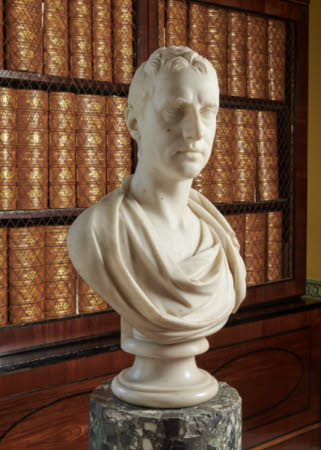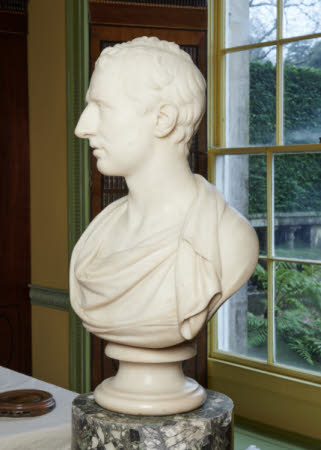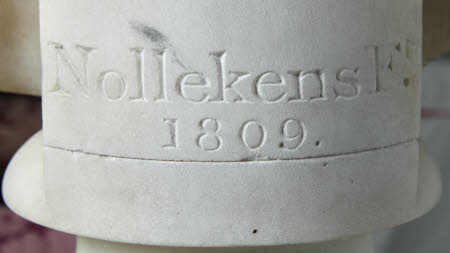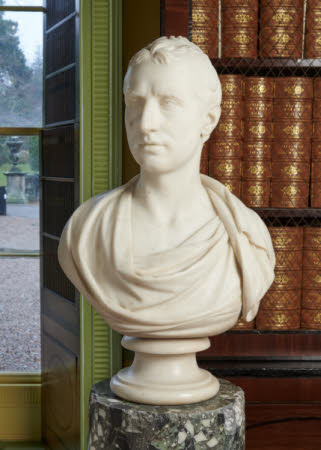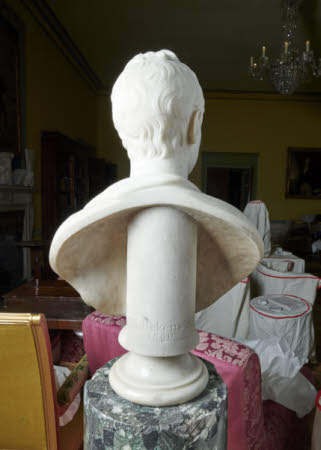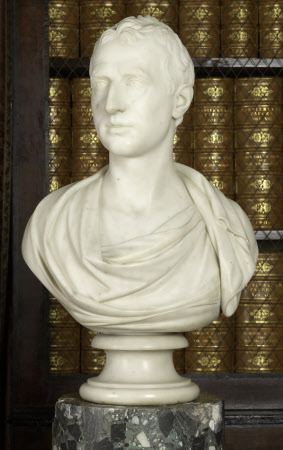Portrait bust of Robert Stewart, 2nd Viscount Castlereagh, later 2nd Marquess of Londonderry
Joseph Nollekens, RA (London 1737 – London 1823)
Category
Art / Sculpture
Date
1809
Materials
Marble
Measurements
673 x 431 x 261 mm
Place of origin
London
Order this imageCollection
Mount Stewart, County Down
NT 1220131
Summary
Sculpture, marble; portrait bust of Robert Stewart, 2nd Viscount Castlereagh & 2nd Marquess of Londonderry, KG, GCH, MP (1769–1822); Joseph Nollekens (1737-1823); 1809. A signed and dated sculpted portrait by Joseph Nollekens of the politician and statesman, Lord Castlereagh, who was instrumental in enabling the passing of the Act of Union by the Irish Parliament. Subsequently, as Foreign Secretary, Castlereagh was one of the key participants in the negotiations at the Congress of Vienna following the defeat of Napoleon Bonaparte.
Full description
A marble portrait bust of Robert Stewart, 2nd Viscount Castlereagh, later 2nd Marquess of Londonderry, by Joseph Nollekens. Castlereagh is depicted looking ahead, head turned slightly to his right, his hair short, with toga-like drapery. Mounted on a turned marble socle. Signed and dated on the back of the bust. Small area of damage on the right cheek. Robert Stewart, the only surviving son from the first marriage of the 1st Marquess of Londonderry, is the key figure in the history of the Londonderry family. In 1790 he entered Parliament as MP for Co. Down, enjoying a meteoric rise through British politics and becoming Prime Minister in all but name. In 1798, as Chief Secretary to the Lord Lieutenant of Ireland, Stewart was wrongly blamed for the violence used to suppress the rebellion that year in Ireland. However, he supported the union of of Ireland with Britain and was subsequently instrumental in ensuring the passing of the 1801 Act of Union. Except for the period 1809-12, Castlereagh was a member of the British cabinet continuously from 1802 until his death in 1822 by suicide, driven by overwork, anxiety and hostility engendered by his efforts on behalf of Catholic Emancipation. In 1812 he returned to government as Foreign Secretary, in which post he helped to bring the Napoleonic wars to a conclusion, before playing a key part in the Congress of Vienna, which aimed not only to reach a settlement with France but also to create a balance of power, in order to ensure a more lasting peace in Europe. Lord Castlereagh had a reputation as a staunch reactionary and tended to excite violent reactions in others, enthusiasm from some, condemnation on the part of others. In 1821, just over a year before his own demise, he succeeded as 2nd Marquess of Londonderry on the death of his father. 1809 might seem an unlikely year for the commissioning of a portrait from the sculptor Joseph Nollekens, since this was the year in which Castlereagh resigned from his position as Minister of War, following a dispute with the then Foreign Secretary George Canning (1770-1827). The matter ended in a duel between the two men, in which Castlereagh wounded his opponent in the thigh. The circumstances of the commissioning of the bust now at Mount Stewart is not known, but in 1811 Nollekens exhibited at the Royal Academy portrait busts of both Lord Castlereagh, perhaps the present bust, and George Canning. Joseph Nollekens was born into a family of artists from Antwerp that had settled in London. As a young man, he was apprenticed to Peter Scheemakers (1691-1781) before travelling to Rome, where he lived for some ten years from 1760. On his return to Britain, Nollekens became one of the most successful sculptors of the day, making many monuments, but also large numbers of portraits. The finest portrait sculptor working in Britain in the late eighteenth and early nineteenth centuries, Nollekens had a remarkable ability to create lively likenesses in which the characters of the subject are strongly expressed. His bust of Lord Castlereagh emphasises the aristocratic good looks of the sitter, slightly elongating the elegant neck, and turning the head slightly so that Castlereagh’s large nose does not become too prominent. The portrait is further enobled through its general affinities with Roman portrait busts, as also suggested by the loose toga-like drapery. Another version of the bust was formerly at Bayham Abbey, in the collection of Lord Michael Pratt. In the disobliging biography of Joseph Nollekens written by his former friend J.T. Smith, an anecdote is told concerning the sittings for this bust, one of many in the book that emphasise the avarice of Nollekens and his wife: ‘When the late Marquis of Londonderry was sitting for his bust, coals were at an enormous price; and the noble Lord, who had been for some time shivering in his seat, took the opportunity, when the Sculptor went out for more clay, of throwing some coals upon the fire. ‘Oh! My good Lord, I don’t know what Mr. Nollekens will say!’, exclaimed Mrs.Nollekens, who was bolstered up and bound to an old night-chair by the fire-side: ‘Never mind, my good lady,’ answered his Lordship; ‘tell him to put them into my bill.’ (Smith 1920, I, pp. 371-72). It is possible at Mount Stewart to compare Nollekens’ portrait of the 40-year old Castlereagh with the version at Mount Stewart of his portrait by the leading portrait sculptor of the next generation, Sir Francis Chantrey (NT 1542341). The first version of Chantrey’s portrait was made in 1821, the last year of the sitter’s life. The 1809 bust of Castlereagh was long displayed in the Inner Hall at Londonderry House, as part of a group of six portrait busts mainly depicting members of the Londonderry family, mounted on yellow scagliola pedestals. The other busts depicted: Napoleon by Canova, dated 1811; Viscount Castlereagh by Chantrey, dated 1821, and another unsigned copy, made after the subject’s death; Henry, 5th Marquess of Londonderry, by Lawrence Macdonald, dated 1856; William Pitt the Younger, by Nollekens, dated 1807. The two Chantrey busts of Castlereagh, and those of the 5th Marquess and of Pitt, were all sold with other sculptures from Londonderry House at Sotheby’s on 16 November 1962. The Nollekens bust of Castlereagh escaped this fate since in 1949, after the death of the seventh Marquess of Londonderry, it was taken from Londonderry House by his widow Edith, now the Dowager Marchioness (annotated note to the 1949 inventory). Jeremy Warren August 2022
Provenance
Londonderry House, the Inner Hall; in 1949, to Edith, Marchioness of Londonderry (1878-1959); Lady Mairi Bury (1921-2009), by whom lent to the National Trust from 1976; accepted by HM Government in lieu of Inheritance Tax and allocated to the National Trust, 2013.
Marks and inscriptions
On back of socle:: Nollekens Ft./1809.
Makers and roles
Joseph Nollekens, RA (London 1737 – London 1823), sculptor
References
Royal Academy, 1811, p. 43, no. 952. Londonderry House 1939: A Catalogue and Valued Inventory of the Furniture and Works of Art at Londonderry House, Park Lane, W... Prepared for the purposes of insurance, with historical notes, by H. Clifford-Smith, 1939, p. 141, Inner Hall. Londonderry House 1949: Inventory and Valuation of the Contents of the Royal Aero Club, Londonderry House, Park Lane, W. [...]. Prepared for the purpose of [Insurance] by H. Clifford-Smith,1949., p. 42, Inner Hall, annotated ‘Gone to the Marchioness Dowager’. Smith, John Thomas,. Nollekens and his times 1920., I, pp. 371-72. Montgomery Hyde 1937 H. Montgomery Hyde, Londonderry House and its Pictures, London 1937, p. 16. Roscoe 2009: I. Roscoe, E. Hardy and M. G. Sullivan, A Biographical Dictionary of Sculptors in Britain 1660-1851, New Haven and Yale 2009, p. 908, no. 288.
